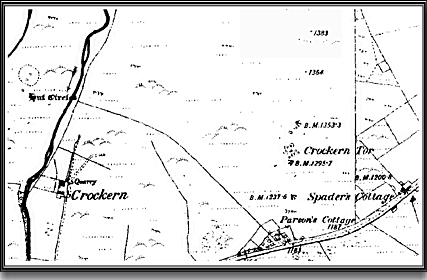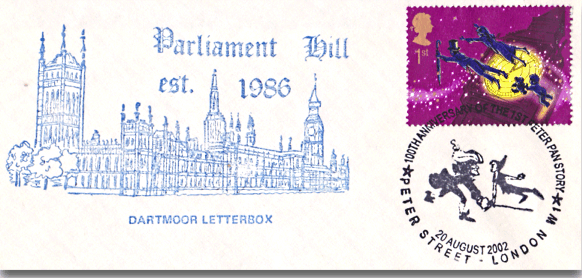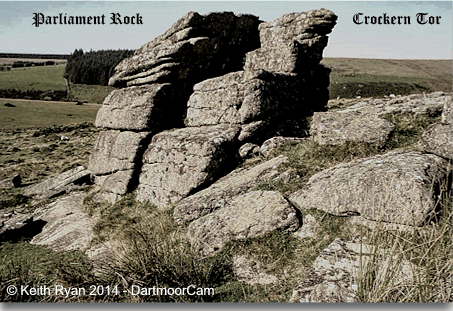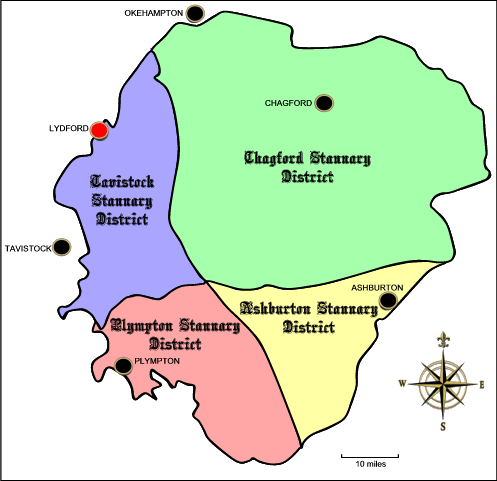
“Nor waving crops, nor leaf, nor flowers adorn
Thy sides, deserted Crockern. Over thee
The winds have ever held dominion ; thou
Art still their heritage, and fierce they sweep.”
Carrington. 1826
Crockern tor is more a place of history than mystery, probably of all the granite outcrops on Dartmoor this one embodies the traditions of the area. Apart from being the home of ‘Old Crockern’ the tor is just about one of the central points of Dartmoor. This made it an ideal venue for the Stannary Parliament, and that is why it became such an important place on Dartmoor. The tor is said to be the home of the ancient pagan God of Dartmoor – Old Crockern. A profile of his face can be seen in the rock formations of the south-western outcrop.
In the 17th century Tristram Risdon listed Crockern tor as one of the three remarkable things on Dartmoor. Of this Risdon, 1811, p.22, said: “A high rock called Crockern Torr, where the parliament for stannary causes is kept; where there is a table and seats of moorstone, hewn out of the rocks, lying in the force of all weather, no house or refuge being near it.” Gover et al, 1992, p.193, plausibly suggests that the name derives from the nearby Crockern Farm, which in turn takes it name from the Old English ‘crocc‘ meaning a pot or vessel and ‘ærn‘ suggesting a house where pots were made or found. This may indicate a one time pottery of some kind. Hemery, 1983, p.427, considers that the name comes from the personal root of the family name ‘Crocker‘ although where the family lived he has omitted to mention. The 1890-91 O.S. map shows the proximity of the farm and tor as seen below:

One question that has been on many a lip is was Crockern Tor a meeting place or Moot for the ancient moor dwellers prior to the tinners? Gomme suggests the following; “The name of Croken Torre,” says Mr. Taylor (Words and Places), “seems to point to a deliberative assembly. The Welsh word gragan, to speak aloud, gives the origin of the word to creak; and the Croken Torre is evidently ‘the speaking hill.’ And moreover, the name of ‘Wistman’s Wood’ in the immediate neighbourhood, suggests the wisdom traditionally imputed to the grave and reverence seniors who took part in the debates.”, p.144. Taylor himself explains his theory on the etymology of Crockern; “We have the Welsh word gragan, to speak loud, whence comes the English verb to croak, to make a loud noise like a frog or raven. The creaking of a door and the name of the corncrake are from the same root. Compare the Sanskrit kruc, to call out, the Greek κρωζω and the Latin crocire.”, p.278. With the help of Polwhele, Gilpin (the godfather of the ‘picturesque’ movement) also adds his pennyworth:
“Mr Polwhele imagines it to have been the seat of British judicature, even prior to the invasion of the Romans. “Distant as it has always been,” says he, “within living memory of man, from every human habitation, we might well be surprised that it should have been chosen for the spot in which our laws were to have been framed, unless some peculiar sanctity had been attached to it in consequence of its appropriation to legal or judicial purposes from the highest antiquity. On this tor, not long since, was the warden’s, or presidents chair, seats for the jurors, a high corner stone for the crier of the court and a table, all rudely hewn out of the rough moor stone of the tor; together with a cavern, which was used in latter ages as a depository for wine… From the nature of this spot open, wild and remote, – from the rocks that were the benches, and from the modes of proceeding, – all so like the ancient courts, and all so unlike the modern, – I judge Crockern to have been the court of a Cantred ( a district of a number of townships) or its place of convention for the purposes of legislature.”, p.81.
In the February of 1905 a report in the Evesham Standard could well back up the theory that Crockern Tor was a place with prehistoric connections. Whilst digging stone for road surfacing on the tor Mr. F. Rounsfell discovered a stone hammer three feet below the surface which was in pristine condition and at the time was said to be over 2000 years old. Described as being; “six inches long, two and a quarter inches wide and weighing twenty five ounces. The eye is an inch in diameter, and narrow towards the centre. One end is round, while the other is chisel-shaped… Some consider it must have been brought from a distant place, as it is of different stone to the ordinary granite of Dartmoor. It is like a very fine, smooth, greyish pebble.” At the time it was thought to be going to some museum as a Dartmoor relic although the finder had received several offers of purchase from private collectors.
One point regarding the ‘cavern’ in which wine was kept, Worth recalls that a workman found under flat stone what was assumed to be a ‘ground stone hammer’ which as he states; “Polwhele’s cave for cellarage of wine, might have been as companion a cupboard for the safe keeping of the Warden of the Stannaries’ gavel.” p.479.
Just to throw another place-name into the pot, during the 1980s the letterbox fraternity called Crockern Tor – ‘Parliament Hill’, a totally fictitious name but one that in certain circles has stuck.

The actual tor stands at 1,300ft (396m) and is made up of two rock piles, the north-eastern one forms a huge, weathered rock-ridge and the south-western outcrop describes a large, natural amphitheatre and was known as Parliament rock. Hemery, 1983, p.429, describes how this rock acts as a natural soundboard allowing the human voice to be amplified over the court area below and in turn voices from the court area could be heard from above. Tradition says that also here was the ‘Judges Table‘ and a naturally formed granite ‘seat known as the ‘Judges Chair’, There is a story which probably dates back to the 1800’s which says when the parliament no longer met at the tor, some of its granite furnishings were taken to build the Dunnabridge pound keepers shelter, to this day it is erroneously known as the ‘Judges Chair’.
Crossing, 1990, p.130 also mentions an unknown rock somewhere near to the tor which was called the ‘Judges Corner‘, he describes it as being “not far from Spader’s Cottage, on the right of the way going into Postbridge, and at a corner of Muddy Lake Newtake.” Butler, 1991, p.67, remarks how in his opinion nothing more than a moorstone table used by the clerk ever existed on the tor and that the rest of the ‘furniture’ was provided by naturally formed rocks.

So what were the stannaries and their parliament all about? Basically it was the tinner’s governing body and the mining districts over which it had jurisdiction. Booker in Gill, 1977, pp.114-20, begins the history of the Stannaries in Saxon times when a stannary court was held in AD950. Here the tinners of Devon and Cornwall were charged dues on the tin mined, mainly because most of the mining land was owned by the Duchy of Cornwall. The Lord Warden was head of the stannary officials and communicated with the King or Prince and the miners. The whole of Dartmoor was deemed a stannary area and so was a self governing ‘mini’ state within a state. This meant it had its own laws, customs, courts and gaol (Lydford). The effect of this was to promote tinners above the common law by right of tinning privileges. Unless a tinner killed, injured or stole he was untouchable by anything except the stannary court. Provided a man was going to mine tin he could leave any feudal service without reproach, he could dig for tin literally wherever he wanted and on any land no matter who owned it. He enjoyed freedom from all ‘tallages, aids, tolls and dues’ at all fairs, ports and markets within his county. In the end the Devon tinners were exempt from paying ordinary national taxes. They were excused any jury service apart from that of the stannary courts and even had the right to muster their own militia in times of war, this was under the command of the Lord Warden. Obviously there was plenty of resentment from non-tinning people, both rich and poor and the system was wide open to abuse with many men using tinning as a ‘convenient’ occupation, all you had to do was grab a shovel and start ‘tinning’.
The history of the ‘Dartmoor’ tin industry began in 1198 when a Westminster civil servant named William de Wrotham was sent to structure the trade on a sound fiscal basis. This was when the Devon miners separated from the Cornishmen with their own Parliament, legislature and seal. There were several reasons for this, a threat of war with France, the cost of the Third Crusade and the huge cost of paying Richard I’s ransom. All meant the ‘national purse’ was empty and in desperate need of replenishment. The first act of the Lord Warden was to put a further tax on the tin industry. Originally a tax of 30 shillings a hundredweight was imposed on the first tin smelting. The new tax added a further one mark on the second smelting. In one year this tax quadrupled the revenue of the stannaries to £600. In the 14th century these taxes were abolished and replaced by the coinage dues which in Devon meant one shilling, six and three-quarter pence per 120 pound of tin. By 1328 the four towns of Tavistock, Chagford, Ashburton and Plympton were designated as centres for the collection of dues known as Coinage Towns.
Once the tin ore had been mined it then had to be smelted and moulded into ingots. This was the ‘first smelting’ and the tin was not that pure, still containing dirt and impurities. It was law that once an ingot was produced it had to be ‘stamped’ in the presence of the stannary keepers and clerk. No person could keep ‘first smelting’ tin for more than 14 days unless it had been officially stamped. The stamped first smelting ingots could not be kept for more than 13 weeks before they had to be taken to the nearest stannary town where it was ‘melted’ and refined. It would then receive another official stamp which certified pure and saleable, Burnard, 1888, p.10. The boundaries of the stannary towns met at Crockern tor and so it was logical to hold the Great Courts or Parliament here.

The earliest known sitting was in 1494 when 24 representatives were summoned from each district to meet at the tor by 8am. Here the customs of the tin works were declared, the rules and regulations of the trade set out and any grievances or petitions heard. There were ten known sittings between 1494 and 1703 and another possible one in 1749. As well as the Parliament Court, each stannary area had a district court but as these were not held at Crockern tor they are outside this current concern. By the mid 1700’s the importance of the stannaries began to wane and the tin industry decline due to the reduced dependency on The Crown for tin revenues. By 1650 the Lydford gaol was described as “a ruin” and finally the last Parliament was held at Crockern in 1749. This sitting merely started with the opening formalities at the tor and then it was adjourned to carry on the business at a more salubrious setting in Tavistock. In 1896 the stannary courts were completely abolished and their jurisdiction handed over to the county courts.
It may have been considered a nice option to become a tin miner but tinner’s law meant some of the justice handed out by the stannary court was far from lenient. The least one could expect was to be sent to Lydford gaol, here you would be subject to ‘Lydford Law’ which meant hang first and judge after. If any miner was caught producing ‘bad ore’ the punishment was, as described by Mrs Bray, “the punishment for him who, in the days of old, brought bad tin to, the market, was to have a certain quantity of it poured down his throat in a melted state. ” For the third offence of tax evasion the guilty party would be taken out to their mine sett and have a knife stuck through the left hand, effectively crucifying the offender to his own wooden boundary marker. There he would stay until he managed to free himself, nobody was allowed to offer assistance. In theory it would sound easy enough for the offender to pull the knife out himself, but once the blade had been taken out the sinews and muscles would be damaged thus leaving a useless hand. Other punishments ranged from fines to confiscation of property, ejection from the Tinners Guild and banishment.

Burnard, R. 1888 On Track of the “Old Men,” Dartmoor, Transactions of the Plymouth Institution and Devon and Cornwall Natural History Society.
Butler, J. 1991 Dartmoor Atlas of Antiquities Vol. II, Devon Books, Exeter.
Crossing, W. 1990 Crossing’s Guide to Dartmoor, Peninsula Press Newton Abbot.
Gill, C. (Ed.) 1977 Dartmoor a New Study, David & Charles, Newton Abbot.
Gilpin, W. 1834. Remarks on Forest Scenery and Other Woodland Views. Edinburgh: Fraser & Co.
Gomme, G. L. 1880. Primitive Folk Moots. London: Low, Marston, Searle and Rivington.
Hambling, P.1995 The Dartmoor Stannaries, Orchard Pub. Newton Abbot.
Hemery, E. 1983 High Dartmoor, Hale, London.
Risdon, T. 1811, The Chronological Description or Survey of the County of Devonshire, Rees & Curtis, Plymouth.
Taylor, I. 1911. Words and Places. London: J. M. Dent and Sons
Walmesley, M. & J. 1982 The Old Men of the Moor, Stockwell Ltd, Ilfracombe.
Worth, R. H. 1988. Worth’s Dartmoor. Newton Abbot: David & Charles.
 Legendary Dartmoor The many aspects past and present of Dartmoor
Legendary Dartmoor The many aspects past and present of Dartmoor

6 comments
Pingback: Britannia, Druids and the surprisingly modern origins of myths - Indilens News Times | Indilens News Times
Pingback: Britannia, Druids and the surprisingly modern origins of myths - StuntFM 97.3
Pingback: Britannia, Druids and the Surprisingly Modern Origin of Myths
Pingback: Britannia, Druids and the surprisingly modern origins of myths – The Conversation – HistoriaAntiqua.org
Pingback: Britannia, Druids and the surprisingly modern origins of myths – theconversation.com – HistoriaAntiqua.org
Pingback: Britannia, Druids and the surprisingly modern origins of myths – The Conversation Indonesia – HistoriaAntiqua.org